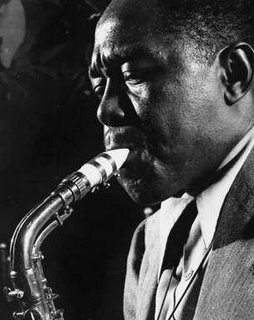Bird

One night in 1939, Charlie Parker stood up in an after-hours chili house in Harlem during a pick-up gig and began to blow his sax along with some guys playing "Cherokee," a tune recently made popular by a Count Basie recording. To analyze what was different about his playing that evening is "inside baseball" -- he improvised on the upper intervals of the chords instead of the lower, whistling a line which required harmonic resolutions which mystified the folks sitting in with him that evening. When the smoke cleared, however, jazz music had begun to enter a new era. The change was so radical, in fact, that it completely alienated older jazz musicians, who derided his style by referring to it as "that Chinese music." Up was down, black was white in Parker's deliberately contrarian world, but nonetheless his approach was exciting to younger players and enthusiasts for its departure from mainstream swing.
It should be no surprise, then, that it took a self-absorbed sociopath to blaze the trail for players like Dizzy Gillespie, Kenny Clarke and Thelonious Monk. Born on this day in 1920 in Kansas City, Kansas and dotingly raised by his mother after his song-and-dance man father abandoned them, Parker's mother bought him an alto saxophone, which in his bristling antipathy against any kind of authority he insisted on teaching himself to play. He dropped out of school at 15 and clumsily tried to sit in with Kansas City bands, but was howled off the stage. He practiced in isolation until he could move with ease from any one key to any other of the remaining 11 keys, not understanding perhaps that most jazz was played in just 4 keys and that all he really needed to know was a few chords to play in a band. He played a summer-long gig at an Ozarks resort and honed his technique, spending his free time copying Lester Young solos.
Back in Kansas City and later in Chicago and New York by the end of 1940, Parker showed he had enough talent to play, but he bounced around from band to band as he alienated musicians with his perverse, sometimes abusive behavior. For the prime-time gigs (with the bands of Earl Hines, Noble Sissle or Billy Eckstine), he stuck largely to the old forms; but jamming in the after-hours clubs, he began to show his amazing improvisational powers, drawing his slow, thin vibrato through harmonic explorations, breaking up rhythms, experimenting with pitch and liberally quoting non sequitir musical quotations from old jazz or traditional tunes -- often at a machine gun tempo with which most sax players of the period could scarcely dream of keeping up. More so than many of the bop players who followed, Parker's playing was his snickering way of telling the world that he was right and they were wrong; it was his private rebellion against everyone.
By 1942, he was playing with trumpeter Dizzy Gillespie, who had begun similar experiments, in the Eckstine big band, but the popularity of their after-hours gigs inspired them to go to Hollywood for a successful series of concerts. Fed up with Parker's erratic behavior and drug abuse, Gillespie soon afterwards left Parker in L.A.
"Bird" (as he was known) was by this time deeply addicted to heroin and alcohol, indulging all of his appetites (for food, drugs, drink and women) like a wild man-child, and though he continued to play well, the excesses stopped him cold as he suffered a physical and mental breakdown in 1946. Perhaps fortuitously, he was arrested on a minor charge and confined to the Camarillo State Hospital, where his health began to improve.
He returned to New York in 1947 and had a tremendous year, touring with his own band comprised of drummer Max Roach and trumpeter Miles Davis; but he was back on drugs and booze, and if anything his obstinate personality turned nastier and more arrogant, leading Roach and Davis to quit in 1948.
He had become a larger-than-life figure by then, however, and was worshipped by younger players as he continued to play clubs (including Birdland, named for Parker himself) and concerts. Narcotics officials succeeded in getting his cabaret license revoked in 1951, limiting his regular playing as ulcers consumed his insides. He enjoyed a few more triumphant performances and recordings, notably a 1953 Massey Hall concert which reunited him with Gillespie and Roach alongside bassist Charles Mingus and pianist Bud Powell, but following a suicide attempt after he threw a public temper tantrum during a gig at Birdland, Parker checked into Bellevue for a couple of weeks to recover.
It was not enough; he wandered around Greenwich Village in an aimless haze for almost a year before he showed up on jazz salonist Baroness Pannonica de Koenigswarter's doorstep, dying there within a few days, on March 12, 1955. He was in such poor condition that the medical examiner estimated his age at 53; he was 34.
Tributes from other musicians flowed, including Mingus' "Gunslinging Bird," the full title of which was "If Charlie Parker were a gunslinger, there'd be a whole lot of dead copycats." Clint Eastwood's biopic, Bird (1988, with Forest Whitaker) attempted in its way to rehabilitate Parker the human being, but at least it reintroduced Parker's music to a 1980s audience.
Labels: Jazz





2 Comments:
If more players taught themselves instrumentation, imagine today's jazz/rock/alternative/jam band genres...alas, the masses wouldn't hear most of them because of the "product" record companies promote...pure disposable garbage...Long Live Mingus, Miles & Bird (sounds like a law firm)!
Extremely insightful!
Please keep the birthday spotlights coming.
Post a Comment
Subscribe to Post Comments [Atom]
<< Home